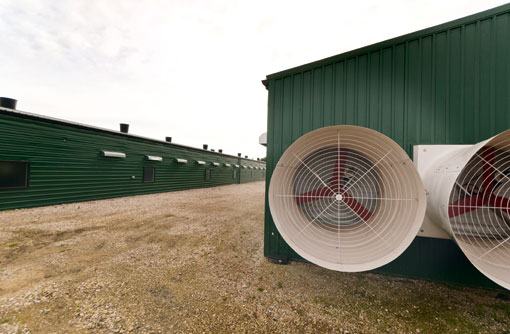Poultry shed air flow’s vital to control disease

Poor ventilation in poultry sheds can present a number of health challenges, leading to poor growth rates, disease and death. But even well-managed units can dip below optimum standards for short times – which can be enough to trigger life-threatening conditions.
Speaking at a recent Datapoul event, Africa Fernandez, company veterinarian at Aviagen, said the most common problem caused by insufficient ventilation was ascites. “Avian blood capillaries are very rigid, so they are unable to expand to deliver more blood to the lungs. When there is not enough oxygen in the air, the heart tries to pump more blood around the body, which results in an enlarged heart and leakage of fluid from the capillaries into the body cavity.”
There was also a strong correlation between cold temperatures and ascites, with thermal stress in the first two weeks of life affecting the metabolic rate for several weeks. “The first 48-72 hours of a bird’s life determines its bodyweight at the end of its life – it’s a critical period. However, duration of cold is more critical than the minimum temperature reached – half a day of sub-optimal temperatures can lead to ascites two weeks later.”
The floor temperature was just as important as air temperature, said Ms Fernandez.
“Temperature and ventilation should be uniform throughout the house – you don’t want hot and cold spots.
“The birds should be using energy to grow, not to keep warm or cool.” Farmers should therefore measure temperature around the house, including at floor level, she added.
Key points
- Uniform good environmental conditions are critical to optimal performance
- Cold temperatures increase the risk of ascites, especially during the first two weeks
- Change ventilation daily as the birds grow
- Adequate ventilation will remove respiratory irritants and reduce the risk of disease
“And consider what happens at night – often there are very large drops in temperature at night.”
Minimum ventilation rates should always be based on bodyweight, not age, and the target temperature should be adjusted daily according to bodyweights and weather conditions. “Every time you weigh your flock you need to adjust your house ventilation and temperature accordingly.”
Good ventilation would provide sufficient levels of oxygen, while eliminating damaging carbon dioxide, carbon monoxide, ammonia and dust, said Ms Fernandez. Ammonia levels above 10ppm would damage the lung surface, and birds would be more susceptible to respiratory disease above 20ppm – the level at which ammonia could be detected by smell. Anything over 50ppm would curb growth rates.
High levels of carbon dioxide would reduce oxygen intake, leading to ascites and death in concentrations greater than 3,500ppm, while carbon monoxide would reduce oxygen binding above 100ppm and result in death at high concentrations.
“Dust will damage the respiratory tract and reduce growth rates – and remember that humidity works in conjunction with temperature – above 29C and 70% relative humidity you will get lower growth rates.”
Incorrect ventilation could allow build-up of these toxic fumes, as well as creating hot or cold spots, she added.
“Poor air quality increases the risk of respiratory disease, which will in turn lead to an increased likelihood of ascites. Turkey rhinotracheitis (TRT) is an opportunistic virus – if the environmental conditions are good, the incidence of disease will be reduced.”
In addition, poor ventilation could result in wet litter, leading to footpad dermatitis and an increased risk of coccidiosis, said Ms Fernandez.
“Uniform environmental conditions are critical to achieving optimum flock performance. If you get the ventilation and temperature right you will have a healthier and more profitable flock.”
Keep up with the latest poultry news
